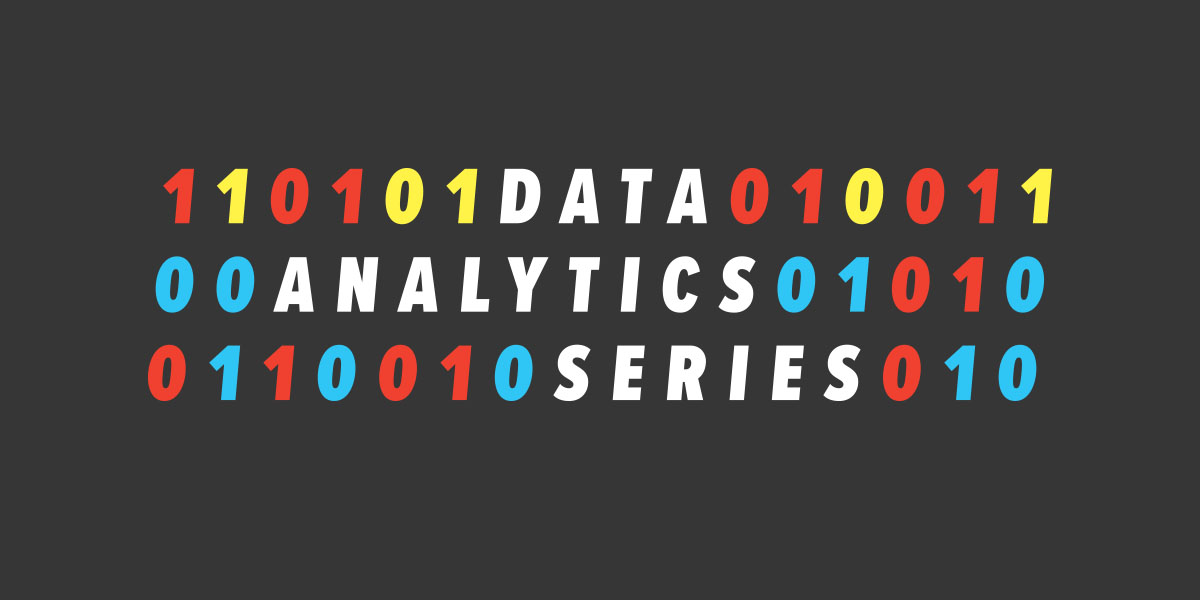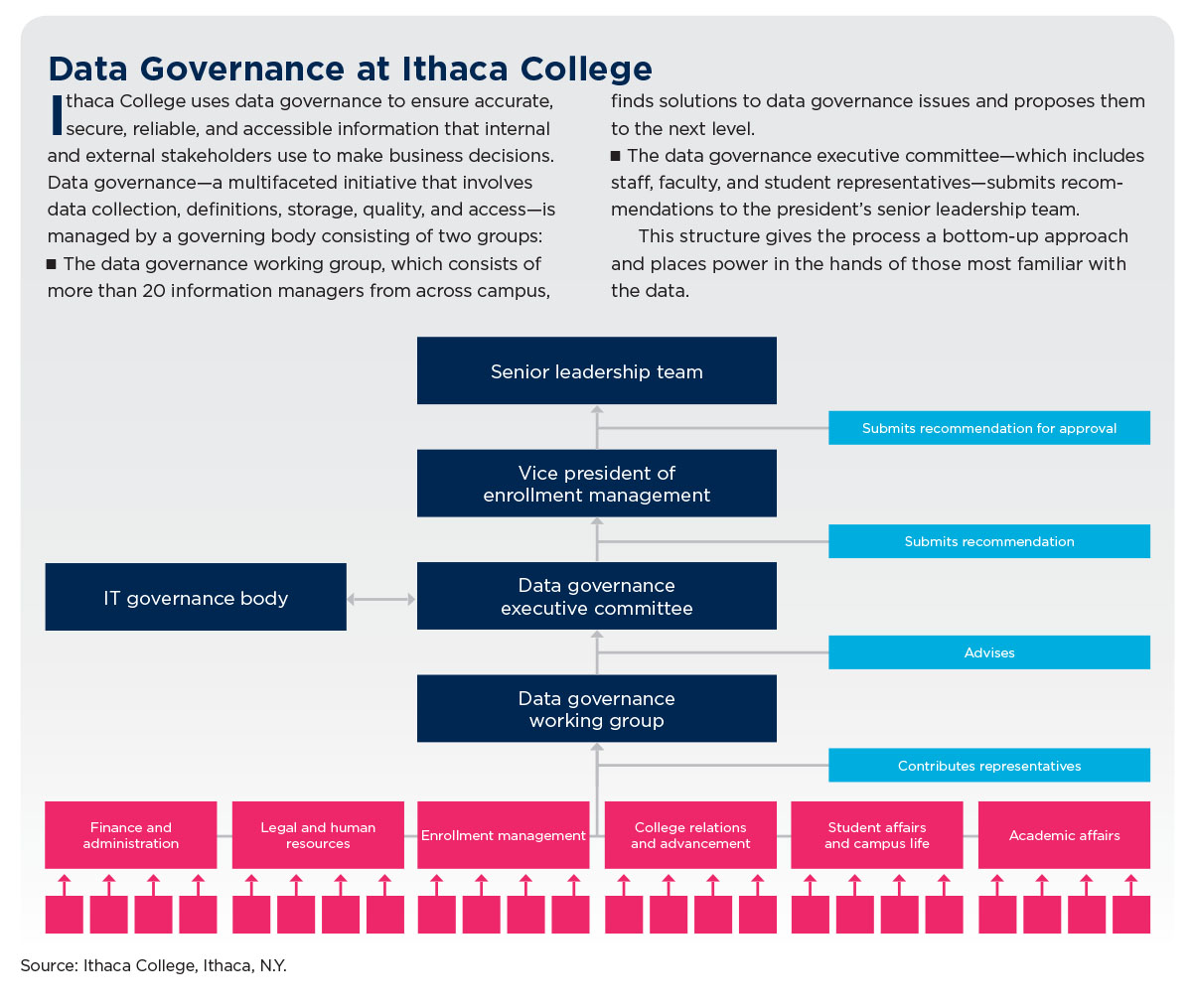
At Ithaca College, Ithaca, N.Y., information technology and the office of analytics and institutional research are strategic partners in helping the institution advance its mission and achieve student success. Both departments, which are dependent on each other, provide services that allow the campus community in general—and our leaders in particular—to make effective strategic and operational decisions. IT has the knowledge and skills regarding the storage, transmission, and flow of the data. The office of analytics and institutional research (AIR) has the expertise to ask strategic questions, analyze data, and interpret answers. (See sidebar, “Mission Critical,” to read the CBO perspective on the roles of the IT and analytics teams.)
IT is not just a technology provider, and AIR is not just a data provider. We are strategic partners who, together, enable the institution’s leaders to make data-informed decisions that advance the college’s mission.
Although our chains of command may be different, both their departments have the same goal: to build a better Ithaca College. IT provides the technology, and AIR provides the analysis and interpretation.
Changing Roles
The way we lead the AIR and IT units at Ithaca College has changed quite dramatically in the past few years. Until 2016, the office of institutional research (IR) was focused on precisely that, providing compliance reporting and historical data to various departments. AIR replaced IR in 2016 and now offers data governance leadership, explores predictive modeling and machine-learning capabilities, and practices data science to advance the college’s mission of creating a student-centered campus.
Previously, the provost used to ask the office, “How many students enrolled last semester?” Now, AIR is focusing on predictive, more future-oriented questions, including: “How many students will we enroll next semester, in three years, in five years?” “Which students are most likely to leave the institution and why?” and “How can we help them return to us next year?”
The eight staff who comprise AIR work on literally predicting the future. By providing analytics-based answers to key questions, leaders across campus don’t just know what happened in the past—they can also start planning for the future and make strategic changes as needed.
Similarly, IT has transformed from a service provider to a service broker. The unit has transitioned from building systems and hosting expansive data centers to focusing on the cloud and taking advantage of virtualization and other technologies. IT assures the appropriate flow of data throughout the institution; the integration of data among systems; the connections to the transaction reporting function; security; and the college’s strategy as it relates to enterprise systems, such as human resources and finance.
In the past two years, Ithaca’s IT organization has become smaller and now has 61 employees. While IT used to hire developers who would write custom applications, it now seeks people with an integration skill set—moving from a tactical focus to a strategic focus and from a technical perspective to a service perspective, in an effort to be proactive, rather than reactive.
This shift in our roles calls for close collaboration from a user-centric perspective. Only through strategic collaboration can we ask—and answer—“What are the most critical questions at our institution?” and “How can we understand and reveal interactive relationships across functional units such as admissions, financial aid, enrollment, curricular and co-curricular learning, and student success?”
Moving to the Cloud
In 2016, AIR and IT began working together to examine options for advancing the college’s enterprise data warehouse and enhancing its analytics system. We explored both on-premise and cloud options.
Ithaca College is a midsize, private institution with five schools, more than 100 programs, and an enrollment of 6,100 undergraduate and 400 graduate students. It doesn’t have the depth of resources of a large institution, so it needed to find efficient and effective ways to provide solutions related to IT and analytics. Looking at what the college needed, the cloud became a cornerstone strategy.
The cloud provides best-of-breed tools necessary for creating predictive models and machine-learning mechanisms to do predictive analysis in real time. It also alleviates the perennial problem of finding appropriate, affordable IT talent in a small college community—a cloud-based solution provides its own experts.
In spring 2017, Ithaca College partnered with a fast-growing data infrastructure and data science company spun off from a university system. The partnership has directly addressed Ithaca’s issues by building an extensible, high-performance data platform in AWS (Amazon Web Services), with models and dashboards that meet its unique needs. The platform enables AIR and IT to pull together data from across the institution—integrating admissions, financial aid, enrollment, student success, and curricular/co-curricular learning data for visualization and advanced strategic analysis.
AIR and IT are beginning to connect the dots in order to answer broader, more strategic questions that will help address critical questions about yield and retention. Even in these early stages of integrating data from various campus offices, AIR and IT have already gained a deeper comprehension of the critical impact of unmet financial needs on the college’s admissions yield, retention, and graduation rate.
Connecting to the National Student Clearinghouse has given the college the data needed to better understand where students enrolled when they did not choose Ithaca College. AIR and IT are also exploring how well financial aid is distributed across different financial need groups by looking at key demographic profile variables, such as race/ethnicity, first-generation status, hometown, and other factors.
Data Governance System
Part of AIR and IT’s collaborative journey has been establishing a campuswide data governance system, which is the very foundation of data management. Several previous efforts that had taken a top-down approach had failed.
Because AIR and IT have decentralized information systems, creating consensus on a centralized definition can be a challenge. One such example is the definition of a “student.” Should people enrolled in not-for-credit courses be considered students? Unless a common definition of “student” could be established, the two units would be unable to correctly count students on campus. However, taking all the varying opinions into consideration and standardizing them into a single definition can be quite a task.
Despite the obstacles, AIR and IT realized what was needed was a campuswide mechanism to ensure secure, accurate, and accessible data for the campus community—because without it, the college could not make reliable decisions. While remaining partners, the two units decided that the leadership for data governance would reside in AIR because its team members possessed in-depth knowledge of how data are strategically used by campus leaders.
To avoid the previous disappointing outcomes, two years ago AIR and IT collaborated with other functional offices across campus and established a data governance discovery group—a small team that studied what would work best for this institution and what kind of tools we needed for data governance. The discovery group agreed on a bottom-up approach.
Today, the college operates with a two-tiered data governance system (see sidebar, “Data Governance at Ithaca College”). At the bottom is the data governance working group—which consists of data managers or report managers from different functional offices, such as financial aid, admissions, and human resources—who handle the data every day.

The discovery group put the power to make decisions in the hands of the working group, which answers questions such as, “What is the definition of a student?” or “How should gender be recorded?” The working group then sends its decisions to the next tier, called the data governance executive committee, which consists of faculty, student, and staff representatives. Once approved, the executive committee sends recommendations to the president’s cabinet.
In order to define the data—functionally and technically—the college uses data governance software that provides a framework to define and catalog definitions. With this robust data dictionary and data governance tool, users can define “student” in the business sense and determine in which system the definition resides. For example, if a user is looking at a report, he or she can move the mouse and see the definition of “student,” how it is used in that particular report, and look up data qualities and specifications.
Data Integration
As institutions depend more and more on cloud-based solutions, the integration of data across solutions becomes a priority. A couple of years ago, the college invested in an Integration Platform as a Service (iPaas) solution that enables connections between software applications to be used in different environments. It is now so much easier to integrate and secure data for wider use.
To help us understand our data assets, AIR and IT recently conducted a data inventory and security audit. The goal was to better understand what data the college has, where they are located, how they are secured, and how the college can protect the data.
AIR and IT are feeding that information into the data governance process, which can help inform the data governance group about what data are out there and which data the college wants to integrate with our analytic systems and reporting.
Avoiding Competition
Transparency, communication, and collaboration are all essential ingredients in the relationship between AIR and IT. Without them, neither unit would have had the trust required to share resources—both financial and staff.
Contrary to popular belief, competition can be avoided. AIR and IT are both dedicated to Ithaca College and want what’s right for the institution. At times, each unit has let go of something, thinking, “Maybe IT should have held onto that” or “Maybe AIR should have kept that.” But we try to look at what makes the most sense for the college. AIR and IT have had conversations occasionally about staff positions, asking, “Does this person belong in IT?” or “Are these skill sets a better fit in AIR?” Usually we find the answer by asking, “What are we trying to accomplish?” and “Where does this position make the most sense?”
And the cooperation isn’t just between the leaders of the IT and AIR units. It’s a matter of daily collaboration between every member of the two units. Some IT staff members attend AIR meetings and vice versa, such that the staff from the two units operate as a collective set. Likewise, each unit keeps its respective vice president informed. AIR reports to the vice president of enrollment management; IT reports to the CFO and vice president of finance and administration. Collaborations between AIR and IT form a solid foundation for effective enrollment management, strategic budgeting, and a stable and healthy financial bottom line.
Eliminating artificial practices that might promote competition between units has been an important lesson for us. Usually this has happened when resources are assigned to a unit or department rather than to a program or service. While the budget for many of the programs and services sits in IT, that is just an administrative function to ensure that bills are paid. The two units are not competing for dollars—we present solutions jointly, putting both names on proposals.
All CFOs can promote this type of cooperation by ensuring that appropriate conversations have occurred before signing off on proposals. For example, if a proposal involves analytics, a CFO might ask, “Have you checked with our analytics officer to get that point of view? I don’t see his or her opinion represented here.”
Over time, joint collaboration becomes part of the institutional norm, as has happened with AIR and IT at Ithaca College. Neither unit would present a technical or analytical strategy without the other being involved.
The missions and skill sets of AIR and IT truly do complement one other. Each brings a different perspective to the table that encourages the discovery of new solutions. Although each unit has different institutional conversations—simply because daily interactions take staff on different paths—those diverging paths add value when we bring them together. Individually, each unit would have gaps in its understanding, but working together provides a 360-degree view of the institution from a data and technology perspective.
YUKO MULUGETTA is chief analytics officer, office of analytics and institutional research, and DAVID WEIL is associate vice president and chief information officer, information technology, Ithaca College, Ithaca, N.Y.



